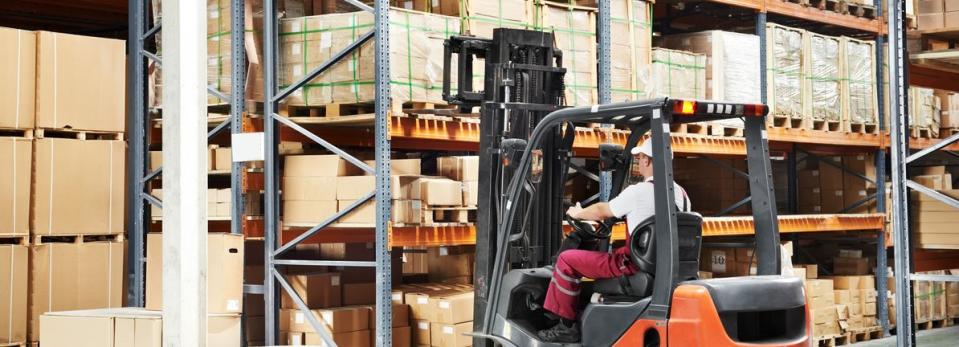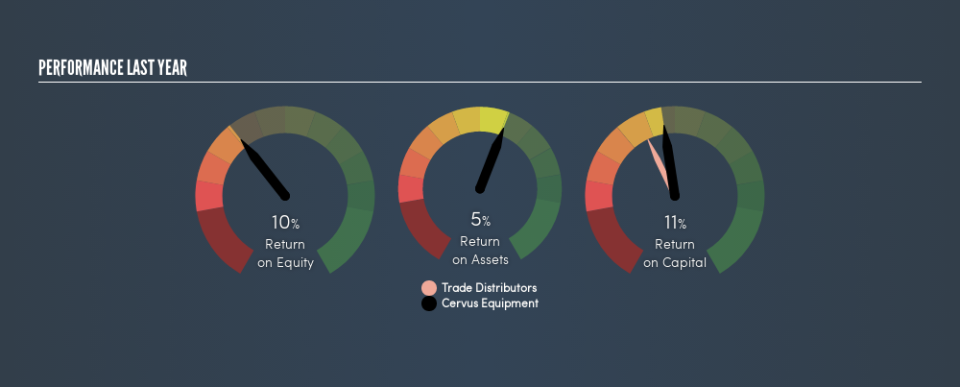Do You Know About Cervus Equipment Corporation’s (TSE:CERV) ROCE?

Want to participate in a short research study? Help shape the future of investing tools and you could win a $250 gift card!
Today we are going to look at Cervus Equipment Corporation (TSE:CERV) to see whether it might be an attractive investment prospect. Specifically, we're going to calculate its Return On Capital Employed (ROCE), in the hopes of getting some insight into the business.
First up, we'll look at what ROCE is and how we calculate it. Then we'll compare its ROCE to similar companies. Then we'll determine how its current liabilities are affecting its ROCE.
What is Return On Capital Employed (ROCE)?
ROCE is a metric for evaluating how much pre-tax income (in percentage terms) a company earns on the capital invested in its business. In general, businesses with a higher ROCE are usually better quality. Ultimately, it is a useful but imperfect metric. Author Edwin Whiting says to be careful when comparing the ROCE of different businesses, since 'No two businesses are exactly alike.'
So, How Do We Calculate ROCE?
Analysts use this formula to calculate return on capital employed:
Return on Capital Employed = Earnings Before Interest and Tax (EBIT) ÷ (Total Assets - Current Liabilities)
Or for Cervus Equipment:
0.11 = CA$42m ÷ (CA$664m - CA$283m) (Based on the trailing twelve months to March 2019.)
Therefore, Cervus Equipment has an ROCE of 11%.
Check out our latest analysis for Cervus Equipment
Is Cervus Equipment's ROCE Good?
ROCE is commonly used for comparing the performance of similar businesses. Using our data, Cervus Equipment's ROCE appears to be around the 12% average of the Trade Distributors industry. Separate from Cervus Equipment's performance relative to its industry, its ROCE in absolute terms looks satisfactory, and it may be worth researching in more depth.
The image below shows how Cervus Equipment's ROCE compares to its industry, and you can click it to see more detail on its past growth.
When considering ROCE, bear in mind that it reflects the past and does not necessarily predict the future. ROCE can be misleading for companies in cyclical industries, with returns looking impressive during the boom times, but very weak during the busts. ROCE is, after all, simply a snap shot of a single year. Since the future is so important for investors, you should check out our free report on analyst forecasts for Cervus Equipment.
What Are Current Liabilities, And How Do They Affect Cervus Equipment's ROCE?
Current liabilities are short term bills and invoices that need to be paid in 12 months or less. Due to the way the ROCE equation works, having large bills due in the near term can make it look as though a company has less capital employed, and thus a higher ROCE than usual. To check the impact of this, we calculate if a company has high current liabilities relative to its total assets.
Cervus Equipment has total assets of CA$664m and current liabilities of CA$283m. Therefore its current liabilities are equivalent to approximately 43% of its total assets. Cervus Equipment has a middling amount of current liabilities, increasing its ROCE somewhat.
Our Take On Cervus Equipment's ROCE
Cervus Equipment's ROCE does look good, but the level of current liabilities also contribute to that. Cervus Equipment shapes up well under this analysis, but it is far from the only business delivering excellent numbers . You might also want to check this free collection of companies delivering excellent earnings growth.
I will like Cervus Equipment better if I see some big insider buys. While we wait, check out this free list of growing companies with considerable, recent, insider buying.
We aim to bring you long-term focused research analysis driven by fundamental data. Note that our analysis may not factor in the latest price-sensitive company announcements or qualitative material.
If you spot an error that warrants correction, please contact the editor at editorial-team@simplywallst.com. This article by Simply Wall St is general in nature. It does not constitute a recommendation to buy or sell any stock, and does not take account of your objectives, or your financial situation. Simply Wall St has no position in the stocks mentioned. Thank you for reading.

 Yahoo Finance
Yahoo Finance 
